NCERT Solution for Class 6 Science Chapter 12 - Beyond Earth
Have you ever looked up at the night sky and wondered about the stars, the moon, and the planets? The questions often appear in our minds, like what makes the moon shine? Why do stars seem to move? How can we tell the difference between a planet and a star? The answers to all these questions lies in NCERT Solution for Class 6 Science Chapter 12 Beyond Earth. In this chapter, students will learn about celestial bodies such as the sun, moon, planets, stars, constellations, satellites and some interesting concepts like the phases of the moon and why we see different constellations at different times.
This Story also Contains
- NCERT Solutions for Class 6 Science Chapter 12: Download PDF
- NCERT Solutions for Class 6 Science Chapter 12 (Exercise Questions with Answers)
- Practice Questions for Class 6 Science Chapter 12
- Approach to Solve NCERT Solutions for Class 6 Science Chapter 12
- Topics Covered in the NCERT Class 6 Science Chapter 12
- NCERT Solutions of Class 6 Science Chapter 12 Summary
- NCERT Solutions for Class 6 Science Chapter-wise
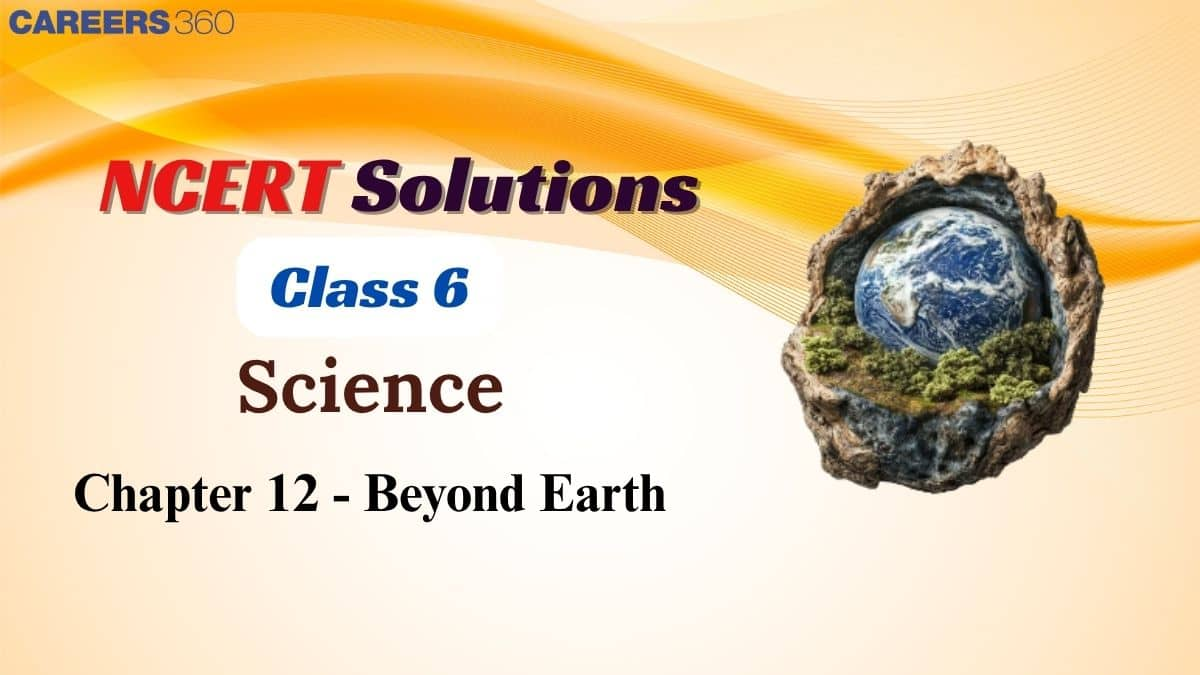
NCERT Solutions for Class 6 Science help students to build a clear understanding of astronomy basics discussed in beyond earth ncert solutions. These solutions explain each topic in a simple and structured manner so that it becomes easier for learners to answer textbook questions and develop a deeper curiosity about space and our universe. Practice questions and approaches to solve question are also discussed in this article.
NCERT Solutions for Class 6 Science Chapter 12: Download PDF
Download the NCERT Solution for Class 6 Science Chapter 12 Beyond Earth PDF from the icon given below. Regular practice and revision of these NCERT solutions will help you turn weaknesses into strengths.
NCERT Solutions for Class 6 Science Chapter 12 (Exercise Questions with Answers)
These class 6 science chapter 12 beyond earth solutions provide clear and step-by-step answers to all the exercise questions given in the textbook. They help students understand concepts better, practise effectively, and prepare well for their exams.
Question 1: Match the column:
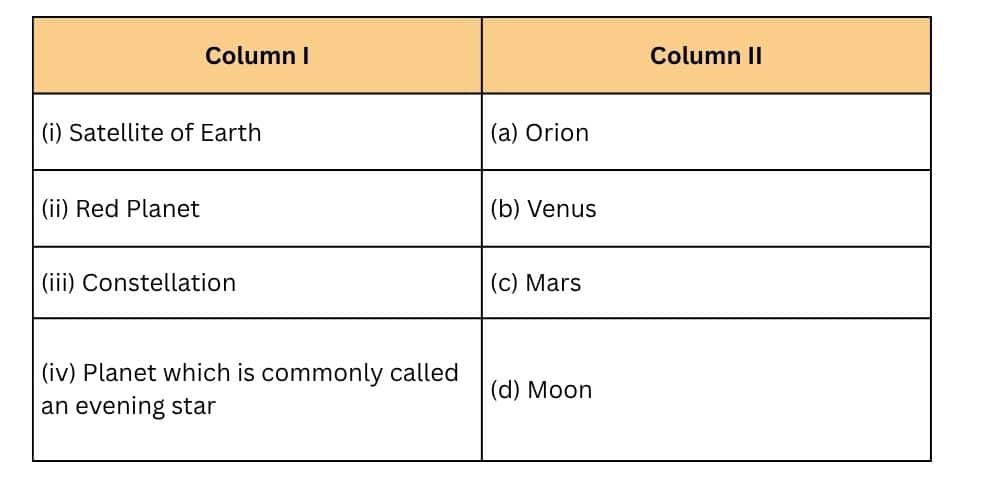
Answer:
|
Column I |
Column II |
|
(i) Satellite of Earth |
(a) Moon |
|
(ii) Red Planet |
(c) Mars |
|
(iii) Constellation |
(b) Orion |
|
(iv) Planet called Evening Star |
(d) Venus |
Question 2(i): Solve the following riddle.
Moon My first alphabet is in MAN but not in CAN
My second alphabet is in ACE and also in FAN
My third alphabet is in RAT and not in CAT
My fourth alphabet is in SUN but not in FUN
I am a planet that moves around the Sun.
Answer:
First letter: M (in MAN not in CAN)
Second: A (in ACE and FAN)
Third: R (in RAT not in CAT)
Fourth: S (in SUN not in FUN)
The planet is MARS.
Question 2(ii): Make two similar riddles by yourself
Answer:
Make two similar riddles by yourself.
My first letter is in EAST but not in FAST
My second letter is in APPLE and PEAR
My third letter is in RAT but not in BAT
My fourth letter is in THREE and TREE
My fifth letter is in HOUSE but not in MOUSE
The answer is EARTH
Question 3: Which of the following is not a member of our Solar System?
(i) Sirius
(ii) Comets
(iii) Asteroids
(iv) Pluto
Answer:
(i) Sirius
Sirius is a star, so it is not part of our Solar System.
(i) Sirius - It's the brightest star in the night sky, located in the constellation Canis Major. It's far away from the Sun.
(ii) Comets- Made of ice, dust, and rock, and they orbit the Sun in long, elliptical paths.
(iii) Asteroids- Rocky objects mostly found in the asteroid belt between Mars and Jupiter. They also orbit the Sun.
(iv) Pluto- It was once considered the ninth planet, but now it's called a dwarf planet. It still belongs to the Solar System and orbits the Sun.
Question 4: Which of the following is not a planet of the Sun?
(i) Jupiter
(ii) Pluto
(iii) Neptune
(iv) Saturn
Answer:
(ii) Pluto
Pluto is no longer considered a planet; it's now classified as a dwarf planet by scientists.
Question 5: Which is the brighter star, the Pole Star or Sirius?
Answer:
Sirius is the brighter star. It's the brightest star in the night sky, while the Pole Star (Polaris) is bright but not as bright as Sirius.
Question 6: An artist’s representation of the Solar System is given in Fig. 12.12. Is the order of the planets correct? If not, write the correct order in the boxes in the figure.
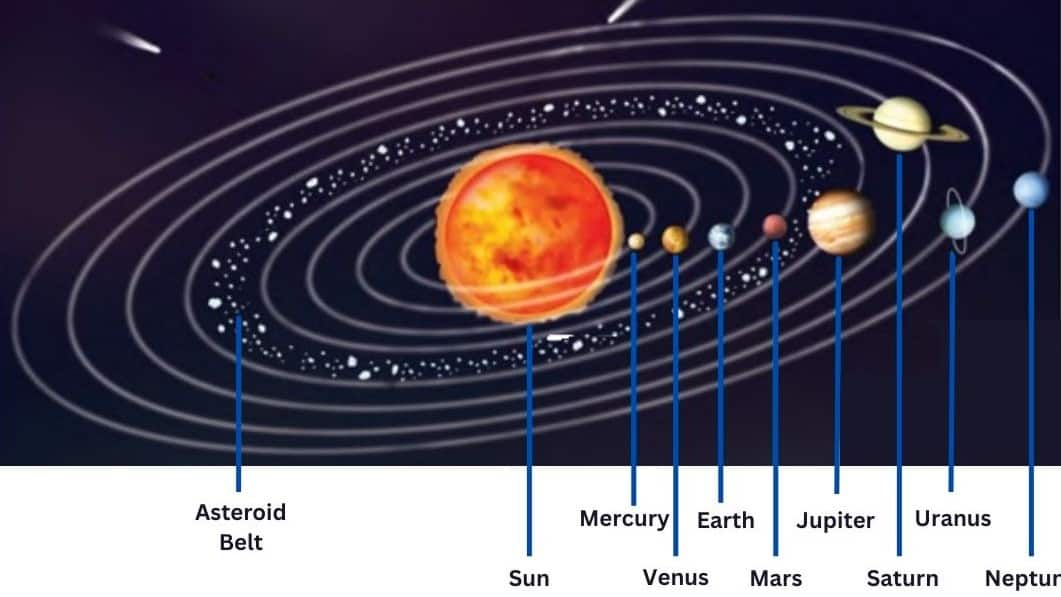
Answer:
The image shows the planet of our solar system, which is in order-
Mercury
Venus
Earth
Mars
Jupiter
Saturn
Uranus
Neptune
Question 7: A portion of the night sky with stars is shown in Fig. 12.13. Look carefully and identify the groups of stars that form the patterns—the Big Dipper and the Little Dipper. Draw lines to connect the stars for these patterns and label them. Also, identify and label the Pole Star. You may refer to Fig. 12.4 for help.
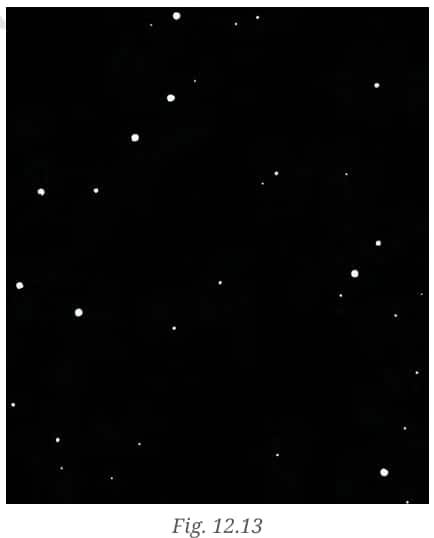
Answer:
Big Dipper (a part of the Ursa Major constellation)- it looks like a big spoon or ladle.
Little Dipper (part of Ursa Minor).
The last star on the handle of the Little Dipper is the Pole Star (also called Polaris).
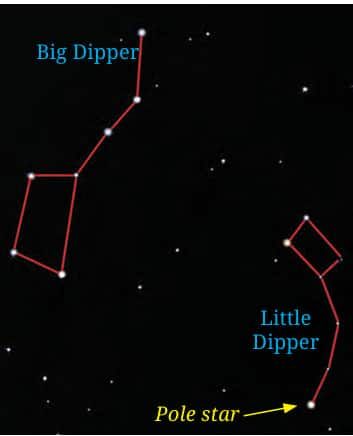
Question 8: A portion of the night sky is shown in Fig. 12.14. Draw lines to connect the stars for Orion and label the star Sirius. You may refer to Fig. 12.3.
.png)
fig. 12.14
Answer:
In Fig. 12.14, you can identify Orion by finding the three bright stars in a straight line; these form Orion’s Belt.
Around this belt, there are four more bright stars that form a quadrilateral or hourglass shape, completing the Orion constellation.
Once Orion is located, look slightly to the left and down from the belt; the brightest star in that region is Sirius. It is not part of Orion but is the brightest star in the night sky and lies close to Orion.
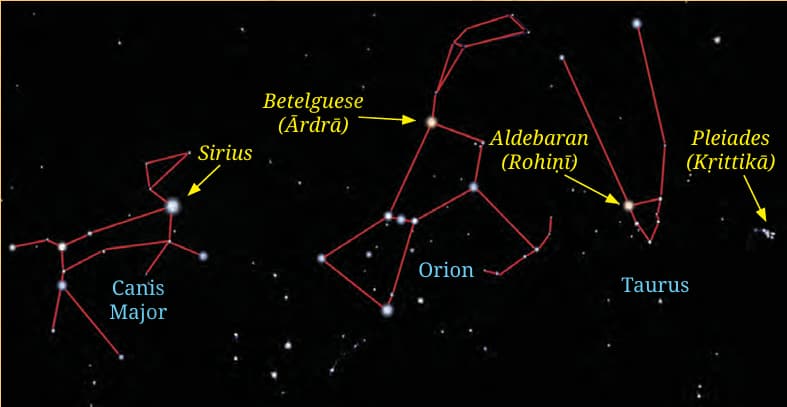
Question 9: You can see stars fading away at dawn and appearing at dusk. During the day we do not see the stars. Explain why.
Answer:
We can not see stars during the day because the bright sunlight scatters in the sky and hides the light of the stars. The stars are still there, but their light gets overpowered by the sun. At dusk, when the sun sets, the sky becomes dark again, and stars start appearing. At dawn, the rising sunlight again fades the stars away.
Question 10: During a clear night, try to observe the Big Dipper 3–4 times at an interval of 2 to 3 hours. Also try to locate the Pole Star each time. Does the Big Dipper appear to move? Draw a rough sketch to illustrate this, mentioning the time in each case.
Answer:
Yes, the Big Dipper appears to move in the night sky. If you observe it every 2–3 hours, you will notice that its position changes slowly around the Pole Star. This is because the Earth rotates and so the stars seem to move in circles around the Pole Star.
Question 11: Think about the night sky and write a poem or a story on it.
Answer:
Once upon a time, in a small village there was a curious little girl named Salma. She used to lay down on her rooftop every night and look up at the twinkling stars. She adored the way they gleamed like tiny diamonds on a black bedspread. One evening, she saw a bright star that never moved. Her grandfather told her that it was the Pole Star and it always stayed in the same place to guide the travelers. She was amazed by this fact and started dreaming about the stars and sky every night.
One night, the stars whispered to Salma, “We are not still. We dance slowly around the Pole Star every night.” She watched patiently and noticed the Big Dipper changing its place in the sky after every few hours. From then on, she started writing messages to the stars in her diary and felt like they were her friends. The night sky was no longer just beautiful but is full of infinite stories.
Practice Questions for Class 6 Science Chapter 12
Some important questions related to class 6 science chapter 12 beyond earth solutions are given below. Students can download these NCERT Solutions for Class 6 from the download icon given above. They help students understand concepts better, practise effectively, and prepare well for their exams.
Question 1: What causes day and night on earth?
Answer:
Day and night happens due to the rotation of earth on its axis, Earth rotates from west to east every 24 hours due to this one half of earth facing earth experience day and the other half facing away from sun experience night.
Question 2: How is new moon night different from full moon night?
Answer:
On new moon night the moon is not visible because the side of the moon facing us does not receive sunlight while on the full moon night the entire face of the moon is visible from earth.
Question 3: Why do stars appear to move from east to west across the sky?
Answer:
Stars appear to move from east to west because earth rotates from west to east. Due to this rotation stars seem to move from east to west.
Question 4: Name the planets of the solar system in correct order starting from the moon.
Answer:
The correct arrangements of plants starting from sun is given below:
1. Mercury
2. Venus
3. Earth
4. Mars
5. Jupiter
6. Saturn
7. Uranus
8. Neptune.
Question 5: What are artificial satellites?
Answer:
Artificial satellites are man-made objects launched into orbit around Earth or other celestial bodies to perform specific functions like communication, weather forecasting, or scientific research.
Approach to Solve NCERT Solutions for Class 6 Science Chapter 12
Given below the approaches to effectively solve class 6 science chapter 12 beyond earth question answer. This chapter of NCERT introduces students to the fascinating world of the solar system, planets, stars, and other celestial bodies, helping them build curiosity about space and the universe.
1. Understand celestial bodies:
Before solving questions it is very important to understand the basic concepts discussed in beyond earth ncert solutions. Understanding of key topics like the Sun, Moon, planets, stars, asteroids, and satellites is essential. Focus more on their characteristics and differences
2. Memorize the solar system:
Learn the names of all the planets in the solar system and order of the planets, understand the movement of planets around the Sun and the Earths rotation, revolution and unique characterstics of each planet.
3. Phases of the moon:
Question from phases of moon topic is frequently asked in exams, understand how and why the Moon changes shape also learn about the concept of one lunar month.
4. Relate Concepts to Real Observations:
Use daily experiences like sunrise/sunset, moon sighting, and seasons to relate textbook concepts. This improves understanding and makes answers realistic.
5. Practicing the questions
Practice class 6 science chapter 12 beyond earth question answer that helps you to develop a proper understanding of the concepts provided in the textbook. These Solutions will help you in practicing the questions effectively.
Topics Covered in the NCERT Class 6 Science Chapter 12
The beyond earth class 6 question answer covers important concepts related to Earth, the Moon, and the solar system. It helps students learn about celestial bodies, their movements, and their significance in our daily lives. These solutions make complex space concepts simple and interesting for young learners.
12.1 Stars and Constellations
12.2 Night Sky Watching
12.3 Our Solar System
12.4 The Milky Way Galaxy
12.5 The Universe
Also check, NCERT book and NCERT syllabus
NCERT Solutions of Class 6 Science Chapter 12 Summary
The class 6 science chapter 12 beyond earth solutions will introduce you to celestial objects like stars, planets, the moon, and constellations. These question answer will explain to you how the stars emit their own light while planets reflect sunlight and revolve around the Sun. These NCERT Solutions will also cover the phases of the moon and will introduce constellations like Orion and the Big Dipper. It will tell you about comets, meteors, man-made satellites and other celestial bodies, including the Pole Star. These beyond earth class 6 question answer will help the students to understand the wonders of the night sky and our place in the solar system.
NCERT Solutions for Class 6 Science Chapter-wise
Besides NCERT Solution for Class 6 Science Chapter 12 Beyond Earth, chapter-wise solutions are given below:
Frequently Asked Questions (FAQs)
Beyond Earth NCERT Solutions for Class 6 Science Chapter 12 are step-by-step answers to all the textbook questions. They explain important concepts about the Earth, Moon, planets, and the solar system in a simple way, helping students understand space and its connection to our daily life.
Studying space expands our knowledge of the universe, enhances our understanding of Earth, and allows us to learn about the origin of celestial bodies.
Chapter 12, Beyond Earth, discusses our solar system, including the sun, planets, moons, asteroids, and comets. It helps students understand the structure of our solar system and the characteristics of celestial bodies. Students can refer NCERT Solution for Class 6 Science Chapter 12 Beyond Earth for understanding these concepts with the help of detailed solutions.
The chapter covers several key components of the solar system: the sun, eight major planets, their moons, dwarf planets, asteroids, and comets. Students can refer NCERT Class 6 Chapter 12 Science PDF for detailed solutions.
The Moon has a stabilizing effect on Earth's axial tilt, which helps maintain a relatively constant climate and facilitates the development and survival of life on our planet. The Moon also causes tides on Earth, which can have important ecological and geological impacts.
Popular Questions
Courses After 12th
Applications for Admissions are open.
This ebook serves as a valuable study guide for NEET 2025 exam.
NEET Previous 10 Year Questions
Get nowThis e-book offers NEET PYQ and serves as an indispensable NEET study material.
JEE Main Important Physics formulas
Get nowAs per latest syllabus. Physics formulas, equations, & laws of class 11 & 12th chapters
JEE Main Important Chemistry formulas
Get nowAs per latest syllabus. Chemistry formulas, equations, & laws of class 11 & 12th chapters
JEE Main high scoring chapters and topics
Get nowAs per latest 2024 syllabus. Study 40% syllabus and score upto 100% marks in JEE
JEE Main Important Mathematics Formulas
Get nowAs per latest syllabus. Maths formulas, equations, & theorems of class 11 & 12th chapters
